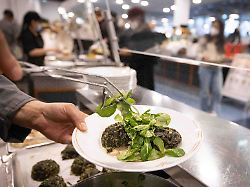So far, any form of genetic engineering has been banned in the cultivation of food in the European Union. The law is no longer up-to-date, criticize researchers. The EU Commission would like to make improvements. The aim is to be able to produce enough food in the face of climate change.
So far, no genetically modified food has been on the plate of Europeans. According to the will of the EU Commission, this should change soon. She is working on a legislative proposal that will allow a certain procedure called “genome editing” in Germany for the first time. This makes it possible to modify the DNA of plants in a targeted manner so that they become more resistant to environmental influences. Critics warn of negative consequences for ecosystems. The EU Commission, on the other hand, sees the use of genetic engineering as an answer to the urgent question of how the supply of food can be secured in the face of global warming.
On the basis of a study commissioned by it, it recognizes forward-looking perspectives for the agricultural and food industry, the commission informed ntv.de. ‘Examples of potential benefits include crops that are more resilient to pests, diseases or the effects of climate change (e.g. droughts), or that require fewer natural resources and fertilisers,’ says the Commission.
In addition, genome editing could improve the nutrient content of plants for healthier nutrition or reduce the content of harmful substances such as toxins and allergens. The Commission intends to present the draft regulation, which still has to be approved by the European Parliament and the member states in the Council, in June.
China invests in healthier soybeans
For Jens Boch, Professor of Plant Biotechnology at Leibniz Universität Hannover, there is no getting around the approval of genome editing to make plants more resilient. “Due to climate change, insects are likely to move north from more southern climes and bring new viruses with them. At the same time, we have to produce more food,” says Boch in an interview with ntv.de. But areas suitable for cultivation are becoming scarce.
In this context, genome editing could conserve resources, especially since it is being developed rapidly through global investment, says Boch. Many countries outside the EU, such as China, the USA or Japan, are funding relevant research with large sums in order to produce soybeans with a healthier oil composition, for example. These foods have so far been subject to an import ban in the European Union.
In genome editing, an enzyme is used that can cut through the DNA at a precise point, like a pair of scissors. The DNA strand is broken. However, the cell does not die because it repairs itself, explains Boch. “This also happens naturally without the use of genetic engineering 25 times a day,” he says.
Ban based on ECJ ruling from 2019
According to Boch, the fears of environmental groups and some Green politicians that genome editing can cause damage to the genome due to inaccuracy are unfounded. He sees a need for regulation more with more modern methods that can rewrite the genome of an organism.
The basis for the ban that is still in force is a ruling by the European Court of Justice (ECJ) from 2019. Boch is not the only scientist to criticize the ECJ’s decision. Research associations such as the Leopoldina are also calling on legislators to be more open to the possibilities of modern genetic engineering.
“From a scientific point of view, genome editing offers advantages over conventional breeding, because chemicals cause thousands and thousands of changes somewhere in the genome,” says Boch. He cannot understand why precisely the precise change is strictly regulated.
Another objection from the critics: Plants modified by genetic engineering that are resistant to any pesticides destroy the ecosystem because they displace other plants. According to Boch, however, such resistant plants are already being produced by conventional breeding and are in circulation. “It hasn’t been seen for 30 years that these plants are spreading in the ecosystem. There’s no evidence for that,” says Boch.
